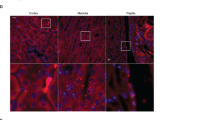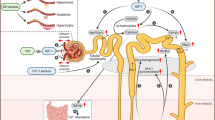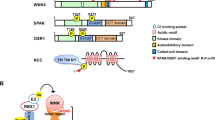Abstract
Insulin and insulin-like growth factor (IGF1) participate in the regulation of renal electrolyte excretion. Insulin- and IGF1-dependent signaling includes phosphatidylinositide-3 (PI3)-kinase, phosphoinositide-dependent kinase PDK1 as well as protein kinase B (PKB) and serum and glucocorticoid inducible kinase (SGK) isoforms, which in turn phosphorylate and thus inhibit glycogen synthase kinase GSK3α,β. Replacement of the serines in the PKB/SGK consensus sequences by alanine (gsk3 KI) confers resistance of GSK3 to PKB/SGK. To explore the role of PKB/SGK-dependent inhibition of GSK3 in the regulation of water/electrolyte metabolism, mice carrying the PKB/SGK resistant mutant (gsk3 KI) were compared to their wild-type littermates (gsk3 WT ). Body weight was similar in gsk3 KI and gsk3 WT mice. Plasma aldosterone at 10 a.m. and corticosterone concentrations at 5 p.m. were significantly lower, but 24-h urinary aldosterone was significantly higher, and corticosterone excretion tended to be higher in gsk3 KI than in gsk3 WT mice. Food and water intake, fecal excretion, glomerular filtration rate, urinary flow rate, urine osmolarity, as well as urinary Na+, K+, urea excretion were significantly larger, and plasma Na+, urea, but not K+ concentration, were significantly lower in gsk3 KI than in gsk3 WT mice. Body temperature was significantly higher in gsk3 KI than in gsk3 WT mice. When allowed to choose between tap water and saline, gsk3 WT mice drank more saline, whereas gsk3 KI mice drank similar large volumes of tap water and saline. During high-salt diet, urinary vasopressin excretion increased to significantly higher levels in gsk3 KI than in gsk3 WT mice. After water deprivation, body weight decreased faster in gsk3 KI than in gsk3 WT mice. Blood pressure, however, was significantly higher in gsk3 KI than in gsk3 WT mice. The observations disclose a role of PKB/SGK-dependent GSK3 activity in the regulation of steroid hormone release, renal water and electrolyte excretion and blood pressure control.









Similar content being viewed by others
References
Akizuki N, Uchida S, Sasaki S, Marumo F (2001) Impaired solute accumulation in inner medulla of Clcnk1−/− mice kidney. Am J Physiol Renal Physiol 280:F79–F87
Artunc F, Amann K, Nasir O, Friedrich B, Sandulache D, Jahovic N, Risler T, Vallon V, Wulff P, Kuhl D, Lang F (2006) Blunted DOCA/high salt induced albuminuria and renal tubulointerstitial damage in gene-targeted mice lacking SGK1. J Mol Med 84:737–746
Barriga C, Martin MI, Tabla R, Ortega E, Rodriguez AB (2001) Circadian rhythm of melatonin, corticosterone and phagocytosis: effect of stress. J Pineal Res 30:180–187
Beurel E, Jope RS (2006) The paradoxical pro- and anti-apoptotic actions of GSK3 in the intrinsic and extrinsic apoptosis signaling pathways. Prog Neurobiol 79:173–189
Bickel CA, Verbalis JG, Knepper MA, Ecelbarger CA (2001) Increased renal Na-K-ATPase, NCC, and beta-ENaC abundance in obese Zucker rats. Am J Physiol Renal Physiol 281:F639–F648
Blazer-Yost BL, Esterman MA, Vlahos CJ (2003) Insulin-stimulated trafficking of ENaC in renal cells requires PI 3-kinase activity. Am J Physiol Cell Physiol 284:C1645–C1653
Blazer-Yost BL, Vahle JC, Byars JM, Bacallao RL (2004) Real-time three-dimensional imaging of lipid signal transduction: apical membrane insertion of epithelial Na(+) channels. Am J Physiol Cell Physiol 287:C1569–C1576
Chen SY, Bhargava A, Mastroberardino L, Meijer OC, Wang J, Buse P, Firestone GL, Verrey F, Pearce D (1999) Epithelial sodium channel regulated by aldosterone-induced protein sgk. Proc Natl Acad Sci U S A 96:2514–2519
Cohen P, Frame S (2001) The renaissance of GSK3. Nat Rev Mol Cell Biol 2:769–776
Cohen P, Goedert M (2004) GSK3 inhibitors: development and therapeutic potential. Nat Rev Drug Discov 3:479–487
Cross DA, Alessi DR, Cohen P, Andjelkovich M, Hemmings BA (1995) Inhibition of glycogen synthase kinase-3 by insulin mediated by protein kinase B. Nature 378:785–789
Debonneville C, Flores SY, Kamynina E, Plant PJ, Tauxe C, Thomas MA, Munster C, Chraibi A, Pratt JH, Horisberger JD, Pearce D, Loffing J, Staub O (2001) Phosphorylation of Nedd4-2 by Sgk1 regulates epithelial Na(+) channel cell surface expression. EMBO J 20:7052–7059
Diakov A, Korbmacher C (2004) A novel pathway of epithelial sodium channel activation involves a serum- and glucocorticoid-inducible kinase consensus motif in the C terminus of the channel's alpha-subunit. J Biol Chem 279:38134–38142
Faletti CJ, Perrotti N, Taylor SI, Blazer-Yost BL (2002) sgk: an essential convergence point for peptide and steroid hormone regulation of ENaC-mediated Na+ transport. Am J Physiol Cell Physiol 282:C494–C500
Firestone GL, Giampaolo JR, O'Keeffe BA (2003) Stimulus-dependent regulation of the serum and glucocorticoid inducible protein kinase (Sgk) transcription, subcellular localization and enzymatic activity. Cell Physiol Biochem 13:1–12
Frame S, Cohen P (2001) GSK3 takes centre stage more than 20 years after its discovery. Biochem J 359:1–16
Harms E, Young MW, Saez L (2003) CK1 and GSK3 in the Drosophila and mammalian circadian clock. Novartis Found Symp 253:267–277
Haussinger D, Roth E, Lang F, Gerok W (1993) Cellular hydration state: an important determinant of protein catabolism in health and disease. Lancet 341:1330–1332
Huang DY, Wulff P, Volkl H, Loffing J, Richter K, Kuhl D, Lang F, Vallon V (2004) Impaired regulation of renal K+ elimination in the sgk1-knockout mouse. J Am Soc Nephrol 15:885–891
Hughes K, Ramakrishna S, Benjamin WB, Woodgett JR (1992) Identification of multifunctional ATP-citrate lyase kinase as the alpha-isoform of glycogen synthase kinase-3. Biochem J 288(Pt 1):309–314
Jope RS, Yuskaitis CJ, Beurel E (2007) Glycogen synthase kinase-3 (GSK3): inflammation, diseases, and therapeutics. Neurochem Res 32:577–595
Kaladchibachi SA, Doble B, Anthopoulos N, Woodgett JR, Manoukian AS (2007) Glycogen synthase kinase 3, circadian rhythms, and bipolar disorder: a molecular link in the therapeutic action of lithium. J Circadian Rhythms 5:3
Kaytor MD, Orr HT (2002) The GSK3 beta signaling cascade and neurodegenerative disease. Curr Opin Neurobiol 12:275–278
Koros E, Dorner-Ciossek C (2007) The role of glycogen synthase kinase-3beta in schizophrenia. Drug News Perspect 20:437–445
Lang F, Bohmer C, Palmada M, Seebohm G, Strutz-Seebohm N, Vallon V (2006) (Patho)physiological significance of the serum- and glucocorticoid-inducible kinase isoforms. Physiol Rev 86:1151–1178
Le Roy C, Li JY, Stocco DM, Langlois D, Saez JM (2000) Regulation by adrenocorticotropin (ACTH), angiotensin II, transforming growth factor-beta, and insulin-like growth factor I of bovine adrenal cell steroidogenic capacity and expression of ACTH receptor, steroidogenic acute regulatory protein, cytochrome P450c17, and 3beta-hydroxysteroid dehydrogenase. Endocrinology 141:1599–1607
Matsui I, Ito T, Kurihara H, Imai E, Ogihara T, Hori M (2007) Snail, a transcriptional regulator, represses nephrin expression in glomerular epithelial cells of nephrotic rats. Lab Invest 87:273–283
McManus EJ, Sakamoto K, Armit LJ, Ronaldson L, Shpiro N, Marquez R, Alessi DR (2005) Role that phosphorylation of GSK3 plays in insulin and Wnt signalling defined by knockin analysis. EMBO J 24:1571–1583
Meneton P, Ichikawa I, Inagami T, Schnermann J (2000) Renal physiology of the mouse. Am J Physiol Renal Physiol 278:F339–F351
Nakatani K, Horinouchi J, Yabu Y, Wada H, Nobori T (2004) Expression of endothelial nitric oxide synthase is induced by estrogen with glycogen synthase 3beta phosphorylation in MCF-7 cells. Oncol Rep 12:833–836
Naray-Fejes-Toth A, Canessa C, Cleaveland ES, Aldrich G, Fejes-Toth G (1999) Sgk is an aldosterone-induced kinase in the renal collecting duct. Effects on epithelial Na+ channels. J Biol Chem 274:16973–16978
Neuhofer W, Beck FX (2005) Cell survival in the hostile environment of the renal medulla. Annu Rev Physiol 67:531–555
Nielsen J, Kwon TH, Praetorius J, Kim YH, Frokiaer J, Knepper MA, Nielsen S (2003) Segment-specific ENaC downregulation in kidney of rats with lithium-induced NDI. Am J Physiol Renal Physiol 285:F1198–F1209
Pearce D (2003) SGK1 Regulation of epithelial sodium transport. Cell Physiol Biochem 13:013–020
Raghavendra V, Agrewala JN, Kulkarni SK (1999) Role of centrally administered melatonin and inhibitors of COX and NOS in LPS-induced hyperthermia and adipsia. Prostaglandins Leukot Essent Fatty Acids 60:249–253
Rao R, Zhang MZ, Zhao M, Cai H, Harris RC, Breyer MD, Hao CM (2005) Lithium treatment inhibits renal GSK-3 activity and promotes cyclooxygenase 2-dependent polyuria. Am J Physiol Renal Physiol 288:F642–F649
Sakoda H, Gotoh Y, Katagiri H, Kurokawa M, Ono H, Onishi Y, Anai M, Ogihara T, Fujishiro M, Fukushima Y, Abe M, Shojima N, Kikuchi M, Oka Y, Hirai H, Asano T (2003) Differing roles of Akt and serum- and glucocorticoid-regulated kinase in glucose metabolism, DNA synthesis, and oncogenic activity. J Biol Chem 278:25802–25807
Shaw M, Cohen P, Alessi DR (1997) Further evidence that the inhibition of glycogen synthase kinase-3beta by IGF-1 is mediated by PDK1/PKB-induced phosphorylation of Ser-9 and not by dephosphorylation of Tyr-216. FEBS Lett 416:307–311
Song J, Hu X, Shi M, Knepper MA, Ecelbarger CA (2004) Effects of dietary fat, NaCl, and fructose on renal sodium and water transporter abundances and systemic blood pressure. Am J Physiol Renal Physiol 287:F1204–F1212
Tong Q, Gamper N, Medina JL, Shapiro MS, Stockand JD (2004) Direct activation of the epithelial Na(+) channel by phosphatidylinositol 3,4,5-trisphosphate and phosphatidylinositol 3,4-bisphosphate produced by phosphoinositide 3-OH kinase. J Biol Chem 279:22654–22663
Vallon V (2003) In vivo studies of the genetically modified mouse kidney. Nephron Physiol 94:1–5
Welsh GI, Proud CG (1993) Glycogen synthase kinase-3 is rapidly inactivated in response to insulin and phosphorylates eukaryotic initiation factor eIF-2B. Biochem J 294(Pt 3):625–629
Wulff P, Vallon V, Huang DY, Volkl H, Yu F, Richter K, Jansen M, Schlunz M, Klingel K, Loffing J, Kauselmann G, Bosl MR, Lang F, Kuhl D (2002) Impaired renal Na(+) retention in the sgk1-knockout mouse. J Clin Invest 110:1263–1268
Yao L, Huang DY, Pfaff IL, Nie X, Leitges M, Vallon V (2004) Evidence for a role of protein kinase C-alpha in urine concentration. Am J Physiol Renal Physiol 287:F299–F304
Zhang YH, Alvarez dlR, Canessa CM, Hayslett JP (2005) Insulin-induced phosphorylation of ENaC correlates with increased sodium channel function in A6 cells. Am J Physiol Cell Physiol 288:C141–C147
Acknowledgments
The authors express their gratitude to Dario Alessi for providing the gsk3 KI mice. The authors further acknowledge the support by the DFG (GRK 1302/1).
Author information
Authors and Affiliations
Corresponding author
Additional information
Krishna M. Boini and Madhuri Bhandaru contributed equally and thus share first authorship.
Rights and permissions
About this article
Cite this article
Boini, K.M., Bhandaru, M., Mack, A. et al. Steroid hormone release as well as renal water and electrolyte excretion of mice expressing PKB/SGK-resistant GSK3. Pflugers Arch - Eur J Physiol 456, 1207–1216 (2008). https://doi.org/10.1007/s00424-008-0483-8
Received:
Accepted:
Published:
Issue Date:
DOI: https://doi.org/10.1007/s00424-008-0483-8




